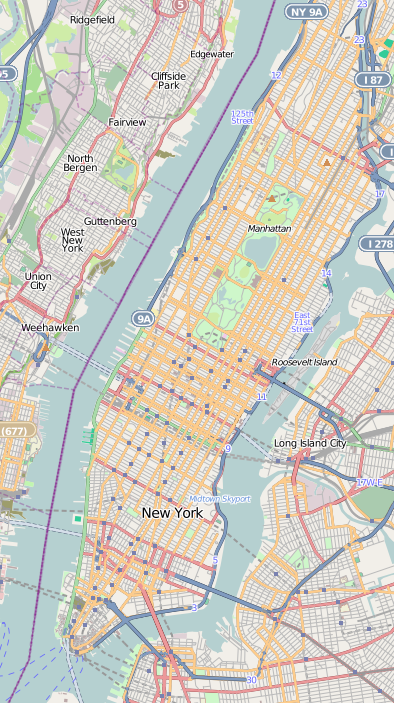The very first step in navigating Manhattan is to understand how it is laid out. Fortunately, Manhattan consists of Streets and Avenues just like other American cities. It largely follows the grid layout and smart street numbering system which is very simple to understand and remember. So read on, and become a pro!
(You might find the Streetwise Manhattan Map useful – it is a folding, pocket sized street map of Manhattan)
How the roads are laid out
The roads are mostly laid out in a grid system – barring the lower part of Manhattan (it is also the oldest part of Manhattan, and therefore, the streets are a little haphazard compared to the rest of Manhattan).
The horizontal roads that run East-West are called Streets, and the vertical roads that run North-South are called Avenues.
Streets
The numbered streets start just north of Houston street, which is in southern (or downtown) Manhattan. Just north of Houston street is 1st street, and the street number increases as we go north. Most streets run parallel to each other.
There are major streets every 10 streets or so – some examples are 14th street, 23rd street, 34th street, 42nd street, etc.

Manhattan Map
Image by Dr. Blofeld (openstreetmap.org) [CC-BY-SA-2.0], via Wikimedia Commons
Avenues
The numbering of the avenues starts from the East – 1st Avenue being the eastern most. The avenue numbers keep increasing as we go west. Most avenues run parallel to each other, but there are some that don’t – a notable exception is Broadway.
Most avenues are numbered, but some avenues have names instead – some of the notable ones are Park Avenue and Madison Avenue. Some avenues also have a name in addition to a number. For example, 6th avenue is also known as “Avenue of the Americas”.
Interesting point: There is no 4th Avenue! Park Avenue and Madison Avenue are at the place where the 4th Avenue should have been.
The East and West of Manhattan
Often, you would find that a tourist attraction is located on “East 42nd street”, or you would hear an address like “212 East 34 Street”.
What is this East and West in Manhattan? Is there a defined logic behind this? Of course!
The split down the Fifth Avenue
Manhattan is split vertically into Eastern and Western regions – and this border is defined by the 5th Avenue. The areas east of the 5th avenue form the eastern part of Manhattan, and the areas west of 5th avenue form the western part of Manhattan.
So, an attraction on the intersection of 6th avenue and 34th street would be in West Manhattan, whereas something on the intersection of 3rd avenue and 23rd street would be in East Manhattan.
Bonus trick to find an address!
Do you know that just by looking at a street address, you can find out between which avenues an address falls? Not many people know this handy trick!
Ok, here it is: The address of any location would have a house or building number (For example, 212 in “212 W 42nd Street”). This number increases as you head away from the 5th Avenue on either side. And between two avenues, there are roughly 100 such house numbers. Using this you can know between which avenues an address falls.
Let’s take an example. Let’s say you want to go to “212 W 42nd Street”. Now you know this is on the 42nd street, but which avenue?
Remember, the house / building numbers increase as you move away from the 5th Avenue. So, roughly speaking, 0-100 W 42nd Street would fall between 5th and 6th Avenues, 100-200 W 42nd Street would be between 6th and 7th Avenues and 200-300 W 42nd Street would be between 7th and 8th Avenues.
So according to our rule of thumb, “212 W 42nd Street” should be between the 7th and 8th Avenues, closer to the 7th Avenue because 212 is closer to 200 than to 300 & the numbers increase as we go away from the 5th Avenue.
Is it actually there? You bet!
Neat, eh?

Speak Your Mind